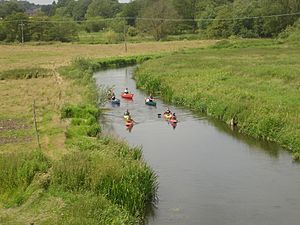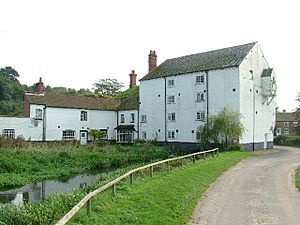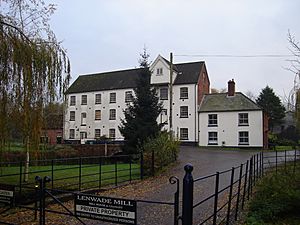River Wensum facts for kids
Quick facts for kids Wensum |
|
|---|---|
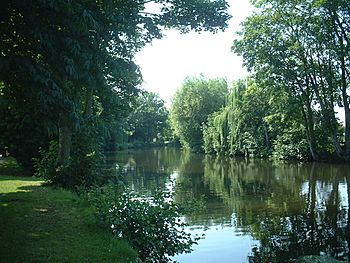
The River Wensum in Norwich
|
|
|
Location of the river mouth within Norfolk
|
|
| Country | England |
| Counties | Norfolk |
| Towns | Sculthorpe, Fakenham, North Elmham, Lenwade, Norwich |
| Physical characteristics | |
| Main source | Whissonsett, Norfolk 52°47′30″N 0°50′47″E / 52.7917°N 0.8464°E |
| River mouth | River Yare Whitlingham, Norwich 52°37′17″N 1°19′23″E / 52.6213°N 1.3230°E |
| Discharge (location 2) |
|
| Discharge (location 3) |
|
| Basin features | |
| Tributaries |
|
The River Wensum is a special kind of river called a chalk river in Norfolk, England. It flows into the River Yare, even though the Wensum is actually bigger! It's a really important place for nature, protected as a Site of Special Scientific Interest and a Special Area of Conservation.
The city of Norwich grew up around this river. The Wensum flows past Carrow Road, which is the home of Norwich City F.C.. One part of the stadium was even named The River End because of it, and fans still call it that today!
Contents
What's in a Name?
The name of the River Wensum comes from an old English word. That word is wandsum or wendsum. It means "winding," which makes sense because the river has many twists and turns!
The River's Journey
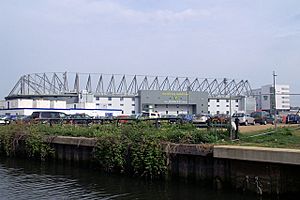
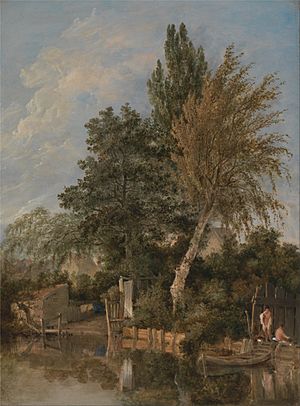
Modern maps show the Wensum starting between the villages of Colkirk and Whissonsett in northwest Norfolk. But older maps say it started in West Rudham. This was from springs on a place called Wensum Farm.
From its start, the river flows near villages like South Raynham and East Raynham. It passes Raynham Hall, a famous old house. Then the Wensum turns north through small villages. It reaches Sculthorpe and turns east through Fakenham.
The river then flows southeast through the Pensthorpe Nature Reserve. It also passes the village of Great Ryburgh. The Wensum continues through or near many other villages. These include Guist, North Elmham, Worthing, Swanton Morley, Lyng, Lenwade and Taverham.
The river then enters the city of Norwich from the northwest. It flows through Drayton, Costessey and Hellesdon. At New Mills Yard, the river becomes tidal. This means its water level changes with the ocean tides. It also becomes deep enough for boats.
As it flows through Norwich, the river makes a big curve. This curve was important for defending the city long ago. You can still see parts of old city walls and towers near the river. For example, Cow Tower is a large defensive tower from the 12th century. It was also used to collect money from boats.
The river was very important for trade. You can still see old mills, docks, and industrial buildings. A special slipway at Pulls Ferry shows where a canal started. This canal was used in the 13th century to bring stone from France. This stone was used to build Norwich Cathedral. Pulls Ferry was also a pub and a river crossing until the 1950s.
The Wensum flows past Carrow Road football ground. Then it leaves the city near Trowse and joins the River Yare at Whitlingham.
Smaller Rivers Joining the Wensum
The Wensum has smaller rivers that flow into it. These are called tributaries.
- The River Tat starts at Syderstone Common. It joins the Wensum west of Fakenham.
- The River Tud starts south of East Dereham. It joins the Wensum just below Hellesdon mill.
- The River Ainse joins the River Wensum at Lenwade.
Watermills Along the Wensum
Many water mills used to be on the River Wensum. Some are still standing today! Here are a few:
- Sculthorpe Mill: This 18th-century mill was turned into a hotel and restaurant in 2003.
- Hempton Mill: This mill was taken down in 1954 to help control the river's water levels.
- Fakenham Mill: This 18th-century mill was used until 1979. It became homes in 1982.
- Great Ryburgh Mill
- Guist Mill
- Bintry Mill: This mill stopped working in 1980. It was used as a filming location for a movie in 1996.
- North Elmham Mill: This mill used waterwheels and then turbines to grind grain. It made animal feed until the late 1900s.
- Swanton Morley Mill: This mill was taken down in the 1840s.
- Elsing Mill: This mill stopped working in 1970, but the building is still there.
- Lyng Mill: This mill was taken down in 1868.
- Lenwade Mill: This old building was saved and turned into apartments in 2000.
- Taverham Mill: In the 1800s, this mill made a lot of paper. Some of it was used for The Times newspaper! The paper mill closed in 1899.
- Costessey Mill: This mill was destroyed by a fire in 1924.
- Hellesdon Mill: This mill was taken down in 1920.
- Norwich New Mills: This mill was built in 1430 to grind corn. Later, it helped supply water to the city. It also used compressed air to pump sewage. All the old machines are still inside!
Bridges in Norwich
Many bridges cross the River Wensum in Norwich.
- Bishops Bridge is one of five medieval bridges. It was built in 1345 and was part of the city's defenses.
- Jarrold Bridge is a bridge just for people walking.
- Fye Bridge is probably the oldest river crossing in Norwich. It was a place where lawbreakers were punished by being dunked in the river!
- Whitefriars Bridge is named after an old monastery called White Friars. You can still see parts of its old walls.
- Foundry Bridge is near the railway station. It was named after a factory nearby.
- Lady Julian Bridge is another footbridge. It is named after Julian of Norwich, a famous writer.
- Carrow Bridge is near the football ground. It's a special bridge that can open up. This lets tall boats pass through.
- Novi Sad Friendship Bridge is a modern footbridge. It's named to celebrate the friendship between Norwich and Novi Sad in Serbia.
There are also other bridges at Barn Road, Anchor Quay, Duke Street, and St. Georges Street.
Protecting the River
The River Wensum is very important, so people are working to protect it. A study in 2002 showed that the river's health was getting worse. This was mainly because of water quality and too much silt (mud) in the river.
Since 2008, a group called the River Wensum Restoration Strategy (RWRS) has been working to fix these problems. They are trying to make the river healthy again. One big problem was the old water mills. They caused 67% of the river to back up. The strategy suggested removing or changing these mills to let the river flow more naturally.
The RWRS has made many improvements. They work with landowners and fishing groups. Their projects include restoring gravel areas and removing silt.
A group called the Norfolk Anglers Conservation Association (NACA) has also done great work. They helped restore a part of the river at Lyng in the 1980s. This work is now used as a guide for other river protection projects.
Fishing in the Wensum
From the 1940s to the 1970s, the Wensum was famous for its roach fish. Some of these fish weighed over 3 pounds (1.4 kg)! But as the river became less healthy, these fish mostly disappeared.
Later, a different type of fish called barbel was put into the river. These fish were not originally from the Wensum. In 1971, over 150 barbel were added. Now, you can find some barbel in the river. Some very large ones have been caught, weighing over 20 pounds (9.1 kg)!
Today, many parts of the upper Wensum are privately owned. But you can still find places to fish. In the city of Norwich, you can even fish for free in some accessible areas.



